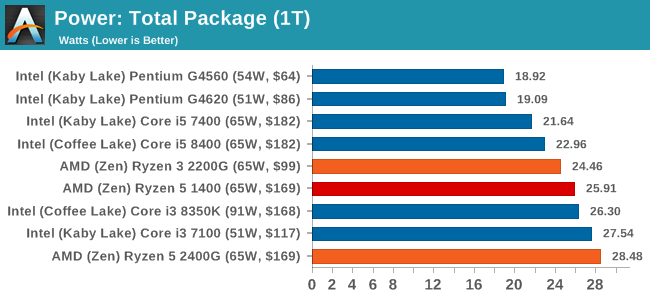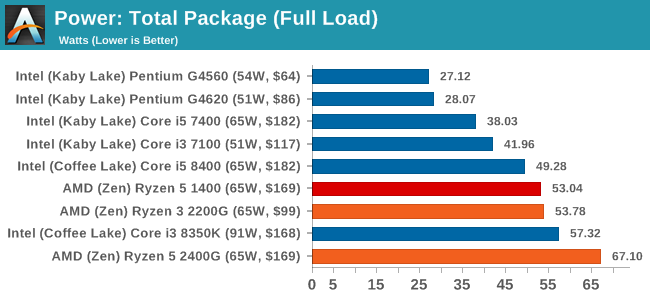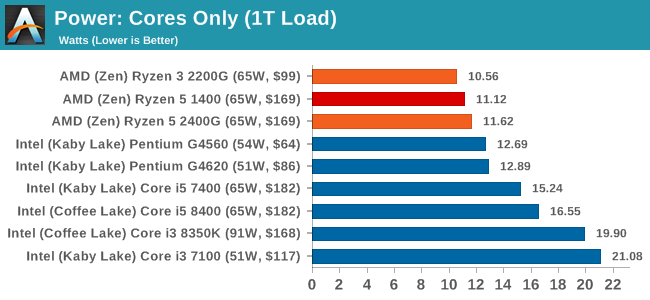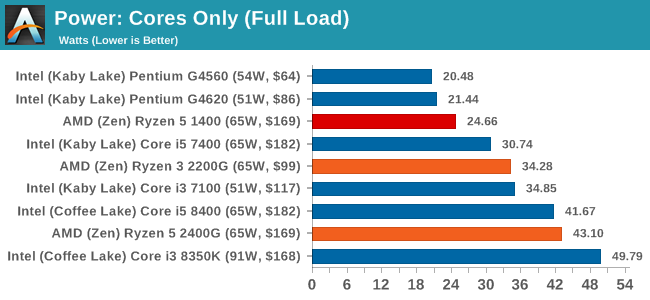Marrying Vega and Zen: The AMD Ryzen 5 2400G Review
by Ian Cutress on February 12, 2018 9:00 AM ESTPower Consumption
For our power consumption metrics, we use a Prime 95 blend on fixed threads to generate a strong load, and then poll the internal power registers that determine power state calculations to get the power consumption. Each processor is different in how it reports its power, which depends on the level of control the processor has: some of the more advanced CPUs, such as Ryzen, will provide per-core power numbers, while the latest Intel CPUs only give a figure for the CPUs as a whole but also include DRAM controller and uncore power consumption.
An interesting element to the power consumption on the Ryzen APUs, due to the unified power delivery subsystem in play feeding the CPU and the integrated graphics, is that the power registers only report half the power consumption when probed (e.g. when 14W, shows 7W). As of yet, we are unsure if this has a knock-on effect on how the processor adjusts its turbo modes in response to power consumption. Nonetheless, a simple scaling factor gives the following results.
Total Package: The Whole Processor
For this data, we take the values of the processor as a whole, which includes all the interconnect, memory controllers, PCIe root complexes, etc. The system is still only loading the CPU cores with minimal effect on the rest of the system, however depending on how the power is managed, some of the sub-systems still remain enabled.


At full load, the difference between the Ryzen 5 and the other Ryzen CPUs shows that the 2400G is using more of its upper margin, compared to the 1400 which is rated at the same power (note TDP is only determined at the base frequency), but the extra frequency of the 2400G means that there is extra power draw overall. Part of this is due to the Infinity Fabric, which we will see below. But what these tests also underline is that in a quad-core configuration, the Intel CPUs are still very power efficient.
Cores Only: Pure Work
For the processors that split out the data, we can look at the power consumption of the cores on their own, without any of the sub-systems, like uncore, mesh, or infinity fabric. This usually paints a different picture to the package power.


For the core only power, the Ryzen 5 2400G uses less power than the Core i3-8350K, despite the situation being reversed when considering the whole package. This means that Infinity Fabric takes a lot of power here, and the ring bus solution that Intel uses benefits from being simpler, and Intel can push more power to its individual cores.










177 Comments
View All Comments
Lolimaster - Monday, February 12, 2018 - link
I would get the Asus X370 pro and the G.Skill Flare X 3200 CL14 (ram is expensive no matter how "cheap" you wanna go)coolhardware - Monday, February 12, 2018 - link
Thank you for the recommendation!!! :-)kaidenshi - Tuesday, February 13, 2018 - link
I'm using the ASRock AB350M Pro4 with a Ryzen 3 1300X, 16GB Crucial Ballistix 2400MHz DDR4 memory, and a GTX 1060 SC. It's been a rock solid board so far, and it has two PCI-E storage slots (one is NVMe, the other is SATA) so you can use it comfortably in a case with limited storage options.I was nervous about it after I read some reviews on Newegg talking about stability issues, but it turned out pretty much all of those people were trying to overclock it far beyond its rated capabilities. It's perfectly stable if you don't try to burn it up on purpose.
Samus - Monday, February 12, 2018 - link
Seriously. It's now obvious why Intel is using AMD graphics. Considering that its mostly on par (sometimes faster, sometimes slower) with a GT 1030, a $100 GPU that uses 30 watts alone, Intel made the right choice using VEGA.Flunk - Monday, February 12, 2018 - link
Wow, that's some impressive numbers for the price point (either of them). I think the R5 2400G would cover the vast majority of users' CPU and GPU needs to the point where they wouldn't notice a difference from anything more expensive. Anyone short of a power user or hardcore gamer could buy one of these and feel like they'd bought a real high-end system, with a $169.99 CPU. That's real value. I kinda want one to play around with, I don't know how I'll justify that to myself... Maybe I'll give it to my father next Christmas.jjj - Monday, February 12, 2018 - link
Was hoping to see GPU OC perf and power, won't scale great unless the memory controller can take faster sticks (than Summit Ridge) but we still need to figure it all out.iter - Monday, February 12, 2018 - link
Most other sites' reviews feature overclocking and power.Ian Cutress - Monday, February 12, 2018 - link
I started an initial run with higher speed memory, but nothing substantial enough to put in the article just yet. I'm planning some follow ups.jjj - Monday, February 12, 2018 - link
Looking forward to all of that.Anyway, they do deliver here for folks that can't afford discrete or got other reasons to go with integrated. Even the 2400G is ok if one needs 8 threads.
Kamgusta - Monday, February 12, 2018 - link
Where is the i5-8400 that has the same price as the 2400G?Oh, yeah, they totally left it out from the benchmarks since it would have proved an absolute supremacy of the Intel offering.
Ops.